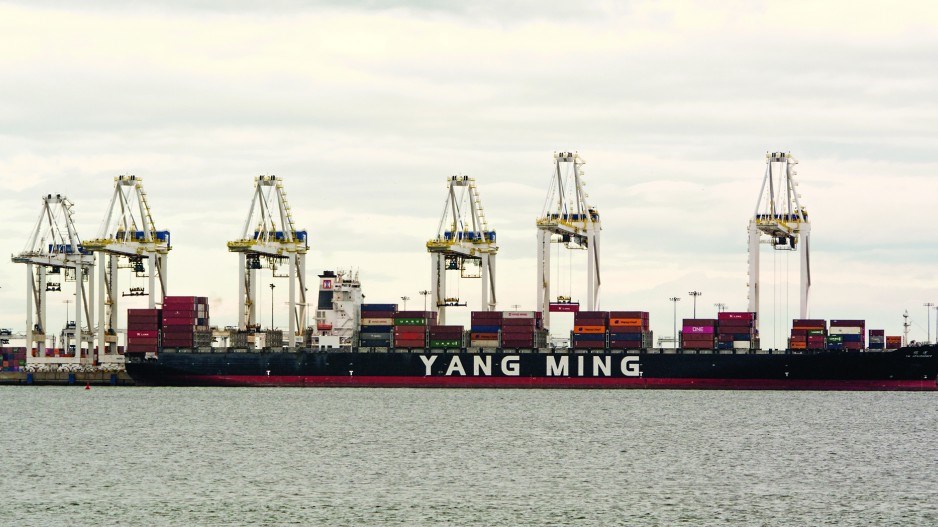The outlook for deep-water container cargo shipping companies is not getting any brighter.
Among the troubling clouds on the near horizon: multibillion-dollar fuel cost increases, a rapidly decelerating global economy and chronic capacity complications on the transpacific and other major trade routes.
As chronicled in “Seaspan Searching For Low-Sulphur Solutions” [Business in Vancouver issue 1561; October 1–7], the looming fuel spike will be driven by new International Maritime Organization (IMO) low-sulphur maritime fuel regulations (IMO 2020) set to take effect in January 2020.
Meanwhile numerous political and trade issues are darkening economic growth forecasts from a wide range of shipping industry and financial analysts.
In June, the World Bank downgraded its 2019 global growth outlook to a weaker-than-expected 2.6%. Its 2020 forecast is not much better: 2.7%.
Since then, organizations ranging from the International Monetary Fund (IMF) to Oxford Economics have joined the downbound trade and global economic slowdown chorus.
The IMF trimmed 0.3 percentage points off the 2019 global growth forecast included in its April world economic outlook. The resulting 3% forecast is the lowest since 2008-09.
Oxford Economics agreed with the IMF’s view that growth in 2019 would be the weakest since the global financial crisis, but the global economic analytics company disagreed with the IMF’s view that growth in 2020 would bounce back to 3.4%.
In a mid-October research briefing, Oxford economist Ben May wrote that “the solid rebound in growth in 2020 anticipated by [the IMF] is too optimistic.”
Oxford’s growth outlook was 2.9% in 2019, followed by a slight increase to 3.1% in 2020.
Also in October, Drewry downgraded its global port throughput growth forecast to 2.6% in 2019 from its previous 3% expectation.
In an October 7 release, the U.K.-based shipping consultancy based the downgrade in part on “the mood music surrounding the container market [having] deteriorated further in the last three months.”
Said Simon Heaney, the company’s senior manager of container research, “The weight of the risks pressing down on the container market seems to be getting heavier by the day. The situation has been exacerbated by a brace of new problems that cloak the market in further layers of concern and uncertainty over those that previously existed.”
According to Drewry, one of the main risks to container shipping buoyancy is IMO 2020 and its impact on container ship supply and operating costs.
As BIV previously reported, global energy consultancy Wood Mackenzie has projected that annual bunker fuel costs could jump by US$60 billion in the wake of IMO 2020.
Drewry estimates that container ship operators will be facing an additional US$11 billion fuel bill next year alone as a result of the required switchover to low-sulphur fuel oil. That added cost could drive some carriers into bankruptcy, which Drewry points out would be one way to rebalance the container shipping sector’s supply-demand equation.
In Drewry’s October 1 quarterly ports briefing, Neil Davidson, senior analyst in Drewry’s ports and terminals practice, said the main theme in the quarter was the global economy’s continued slowdown. He noted that the trend in annual container port throughput growth had been accelerating since mid-2016.
“But the rate of growth is now clearly slowing amid global economic uncertainty, and this rolling annual rate has seen its fifth consecutive quarter of slowing growth, dropping to 3.2% in the second quarter of 2019.”
The outlook for the transpacific and other key trade loops that feed major ports in B.C. and elsewhere in North America is even more uncertain as the high tide of shippers front-loading orders early in the year to beat U.S. tariffs on Chinese exports has crested and eliminated the transpacific’s traditional peak container season.
Davidson noted that five-year container port throughput growth rate forecasts for Latin America (3.7%) and North America (3.6%) are below the world average (4.4%).
Responding to questions from briefing attendees, Davidson said that changes in trade patterns caused by the ongoing China-U.S. trade skirmishes could become permanent.
“But more important are two macro factors that are bigger than the short-term impact of trade wars. Firstly, the changing nature of China’s economy – with an increasing focus on domestic production and consumption – and, secondly, the increasing trend for regionalization as opposed to globalization.”•
@timothyrenshaw




